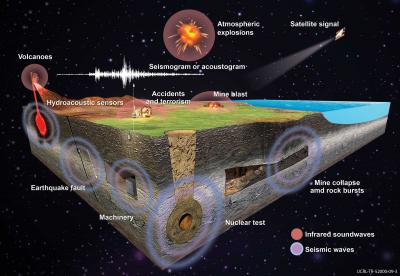For more than a decade, Laboratory seismologists have used available seismic data to develop and verify one- and two-dimensional regional Earth models. Today, with high-performance supercomputers, seismologists can capture three-dimensional effects to more precisely detect, locate, and identify a nuclear explosion. Several new computational techniques are effective for revealing the effects of topography and pinpointing the location of seismic events with very high accuracy. Yet another new computerized approach will automatically analyze seismograms.
These new methodologies not only improve our country's ability to monitor nuclear explosions but also allow researchers to better define seismically active faults where small earthquakes may occur. Seismic research does double duty!
This cutaway through Earth's subsurface shows many of the disturbances recorded by seismic sensors worldwide. LLNL is responsible for developing tools that can quickly and accurately distinguish a nuclear test (foreground) from other seismic activity. (Click on image for larger view).





